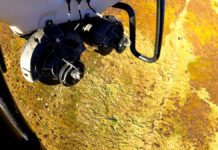
A waste management company was fined £612.81 and two of senior staff £900 each on 18 February 2019 for illegally disposing of waste at a site in Penicuik.
According to a press release from the Scottish Environment Protection Agency (SEPA), D.A.M. Recycling pled guilty to keeping controlled waste without the authority of a waste management licence. Alan O’Connor, a director, and David Shaw, a manager, of the company pled guilty to consent, connivance or neglect in failing to ensure that only the inert wastes permitted were deposited at Bowlea Smithy.
SEPA says it submitted the case to the Procurator Fiscal after an extensive investigation.
Terry A’Hearn, SEPA’s Chief Executive, said:
“SEPA is committed to cracking down on waste criminals and this case was the first for SEPA’s specialist Waste Crime Team. Their specialist skills were essential in investigating this company and its directors, and the number of staff involved from across the organisation demonstrates our commitment to tackling criminal behaviour. They worked hard to bring the perpetrators to justice.
“We’re disappointed that these activities took place, despite the best efforts of SEPA officers, but we are pleased they have been held to account. We hope this successful prosecution sends a message to everybody operating in Scotland. SEPA is here to make sure that action will be taken if you don’t pay attention to your environmental responsibilities.”
In February 2013 a Waste Management Licence exemption was granted for the use of waste soil and stone to raise the height of a field so it could be returned to agricultural use. The exemption was for a maximum of 20,000 tonnes. This type of exemption only allows pre-sorted waste soil and stone, which are classed as inert waste, to be brought on site. No other type of waste is permitted.
SEPA started receiving complaints not long after that suggested both the type and quantity of waste being brought on site was outwith the exemption. Initial investigations by SEPA officers failed to find evidence of this, but complaints were ongoing. In December 2013 SEPA’s Waste Crime Team began directed surveillance activity and SEPA officers witnessed waste being driven on to the site and immediately buried under soil and stones in order to hide it.
SEPA employees from a variety of disciplines including specialist Waste Crime Team officers, field chemists, ecologists and hydrologists, together with external contractors, including a Land Surveyor assessed the site and took various samples for analysis.
Concentrations of methane and carbon dioxide gases emitting from a site are indicative of decomposition from non-inert wastes. The gas measurements taken showed significantly elevated levels of methane and CO2 in certain areas. These elevated levels informed SEPA as to which areas to further investigate by the digging of test pits.
A total of 12 test pits were dug and illegal waste was excavated from eight of them. This included waste plasterboard, glass, wood, plastics, metals, insulation materials, plastic sheeting, roofing felt, plastic piping; household items and municipal wastes including paper, plastics, food waste, food packaging, clothing, mattresses, sofas cushions, paper, carpets, newspapers, shoes, cardboard and bags. All were buried between one and four metres underground and had been covered with waste soil and stones.
Strong unpleasant odours, described as a rotten egg smell, were noted during site assessments by SEPA staff and contractors. This can be attributed to the hydrogen sulphide content of the gas created by decomposing controlled waste found to be buried at the site. During excavations black rotting waste including mattresses, carpets and plastics was discovered, and SEPA staff detected a very strong smell of decomposing waste. SEPA has continued to monitor the site. It was estimated that 20,480 tonnes of inert wastes were buried.
Alan O’Connor and David Shaw were served with a Statutory Notice in April 2014 requiring them to move all the wastes not conforming to the original Waste Management Licence Exemption but the Notice was not complied with by August 2014.
Gas monitoring in September 2017 showed that landfill type gas was still being produced.
Jim Ferguson, SEPA’s Reporting Officer, said:
“Between 7.00 and .45 each week day morning, an excavator would dig a hole at the site and a lorry would arrive and deposit its load into the hole, which was then immediately covered up. This was very quick compared to the rest of the work conducted during the rest of the day, where inert construction waste and soils were left openly on the ground before spread out on top of the site. This activity showed a deliberate attempt to hide the nature of the waste being buried at the site, by people who knew it was not permitted.
“The site was essentially being run as an illegal landfill site. A legal facility would have authorisation from SEPA to ensure protection of the environment, including requirements for containment of potentially harmful emissions to the environment, site security, controls over the type of waste accepted and protection of the nearby Lead Burn. This site charged to accept waste that was deposited there, but did not have any of the associated running costs.
“We hope this case is also a reminder to anyone who entrusts their waste to others. You have a duty of care too – you must ensure your waste only goes to a carrier that is appropriately registered, and that they take it to an appropriately licenced site. You can find out more on our website.”






